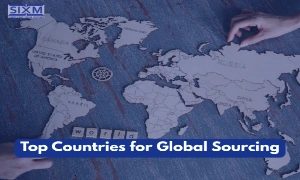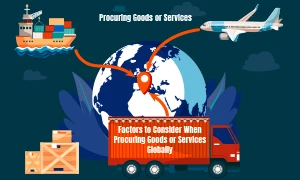Sourcing from Asia offers small businesses access to affordable manufacturing, skilled labor, and a vast supplier network. To succeed, businesses should start by selecting the right country based on product type, budget, and lead time. Platforms like Alibaba or working with local sourcing agents can help identify trustworthy suppliers. It’s essential to negotiate clear terms, prioritize quality control, and understand shipping and customs logistics. By combining cost efficiency with strategic supplier relationships, small businesses can scale faster while maintaining product quality and operational resilience.
In this blog, we’ll break down practical sourcing strategies small businesses can adopt to succeed in Asia.
How Small Businesses Can Source Smartly from Asia
Sourcing from Asia can open up major growth opportunities for small businesses but success depends on making smart decisions at every step, from selecting the right country to building reliable supplier relationships.
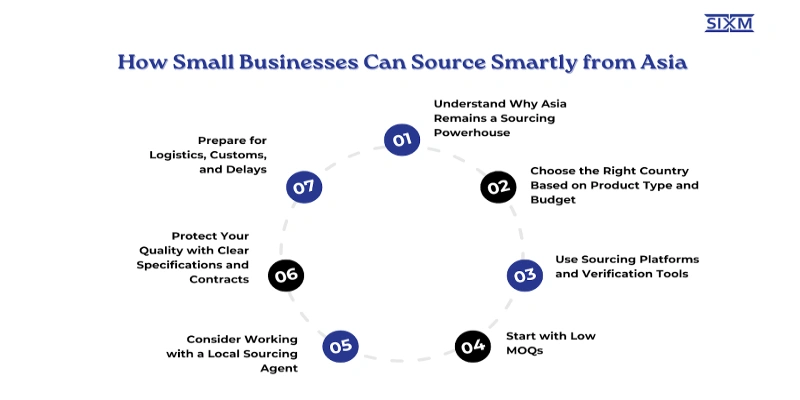
1. Understand Why Asia Remains a Sourcing Powerhouse
Asia dominates global sourcing for several reasons:
- Cost Efficiency: Labor and production costs in countries like China, India, Vietnam, and Bangladesh remain significantly lower than in Western markets.
- Manufacturing Expertise: Decades of experience in sectors like textiles, electronics, and plastics make Asian suppliers highly skilled and specialized.
- Production Scale: Asian manufacturers often have the capacity to handle both small and large orders, giving businesses flexibility as they grow.
2. Choose the Right Country Based on Product Type and Budget
Not all sourcing destinations in Asia are the same. Here’s a quick overview:
| Country | Best For | Key Advantages |
|---|---|---|
| China | Electronics, plastics, general goods | Established infrastructure, scalability |
| India | Textiles, leather, jewelry | Strong raw material base, English-speaking |
| Vietnam | Apparel, furniture, footwear | Competitive pricing, rising quality |
| Bangladesh | Garments, knitwear | Low labor cost, large workforce |
| Thailand/Malaysia | Electronics, automotive parts | Skilled workforce, stable regulations |
Tip: Don’t just chase the lowest cost. Factor in quality control, shipping timelines, political stability, and intellectual property protection.
3. Use Sourcing Platforms and Verification Tools
For small businesses without in-country offices, platforms like Alibaba, GlobalSources, and Made-in-China offer access to thousands of suppliers. However, vetting is key.
Verification Strategies:
- Look for “Gold” or “Verified” suppliers.
- Request certifications (ISO, CE, etc.).
- Use third-party inspection companies.
- Check online reviews and trade history.
Pro Tip:
Consider platforms like ImportYeti to see which suppliers your competitors are using.
4. Start with Low MOQs (Minimum Order Quantities)
One of the biggest barriers for small businesses is high MOQs. Many Asian suppliers cater to large corporations, but there are ways to negotiate:
- Be clear about your growth potential as a buyer.
- Group orders with other small businesses through sourcing agents.
- Start with a sample run before committing to larger quantities.
5. Consider Working with a Local Sourcing Agent
If language barriers, cultural gaps, or factory visits are a challenge, hiring a local sourcing agent can be a game changer. These professionals:
- Negotiate pricing on your behalf.
- Perform on-site factory audits.
- Manage shipping and customs.
- Help avoid scams or low-quality suppliers.
This is especially useful if you’re sourcing from China, India, or Vietnam, where regional practices can vary widely.
6. Protect Your Quality with Clear Specifications and Contracts
Don’t leave quality to chance. Always provide:
- Detailed product specs and drawings
- Agreed tolerances and packaging instructions
- Clear timelines and penalties for delays
Use a purchase agreement that outlines payment terms, delivery schedule, quality requirements, and recourse for disputes.
7. Prepare for Logistics, Customs, and Delays
Sourcing from Asia requires planning ahead:
- Use freight forwarders to handle customs and documentation.
- Factor in lead time (typically 30–60 days, depending on country and shipping method).
- Understand Incoterms (FOB, CIF, EXW) to avoid surprise costs.
Bonus Tip: Consider using a third-party logistics (3PL) partner for warehousing and fulfillment if shipping directly to customers.
Sourcing Methods for Small Businesses
Small businesses can approach sourcing in several ways, depending on their experience, budget, and product complexity. Below are the most common and effective methods to consider.
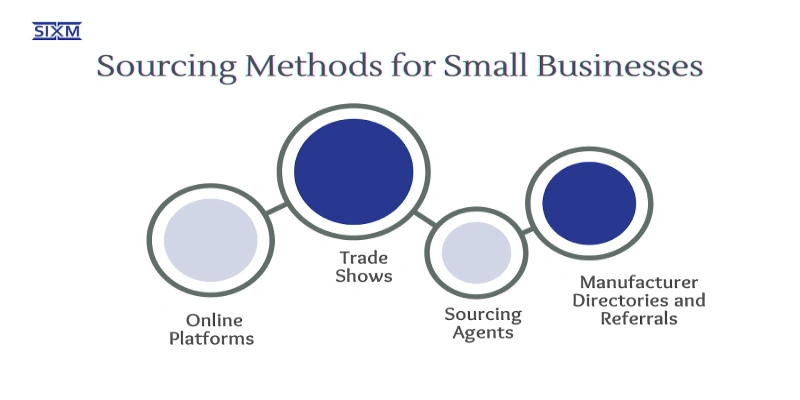
1. Online Platforms
Websites like Alibaba, GlobalSources, Made-in-China, and IndiaMART make it easy to find suppliers. These platforms offer:
- Product catalogs and supplier profiles
- Reviews and ratings
- Communication and quoting tools
2. Trade Shows
Events like the Canton Fair (China), India International Trade Fair, or ASEAN fairs offer direct interaction with suppliers. Attending in person allows for:
- Real-time product evaluation
- Relationship building
- Faster decision-making
3. Sourcing Agents
Local agents can simplify the process for small businesses that lack experience or language proficiency. They:
- Vet suppliers
- Negotiate contracts
- Handle quality control and logistics
4. Manufacturer Directories and Referrals
Industry directories or referrals from business peers can lead to vetted, trusted suppliers not always found online.
Five Supply Chain Strategies for Asia Sourcing
Sourcing from Asia offers small businesses incredible opportunities but to fully capitalize on them, businesses need strategic supply chain models that go beyond basic procurement. These five transformative strategies can help you increase efficiency, adapt faster, and build long-term resilience in your supply chain.
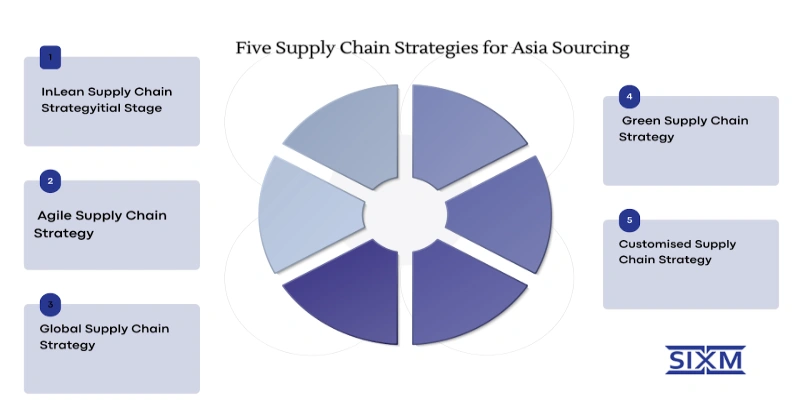
1. Lean Supply Chain Strategy
Focuses on minimizing waste and optimizing resources. Small businesses can adopt just-in-time inventory and streamline transportation to reduce costs.
Benefit: Cuts unnecessary expenses and improves efficiency.
2. Agile Supply Chain Strategy
Designed for responsiveness and flexibility. This strategy enables businesses to react quickly to demand changes or disruptions by staying connected with suppliers and leveraging real-time data.
Benefit: Supports rapid adaptation in volatile markets.
3. Global Supply Chain Strategy
Involves managing suppliers and logistics across multiple countries. Small businesses can diversify supplier bases in Asia to balance quality, cost, and risk.
Benefit: Expands reach and builds a more resilient supply chain.
4. Green Supply Chain Strategy
Prioritizes environmentally sustainable practices, such as working with eco-conscious suppliers and optimizing packaging and transportation.
Benefit: Aligns with growing consumer demand for ethical brands.
5. Customised Supply Chain Strategy
Focuses on personalization and tailored manufacturing. Businesses can collaborate with Asian suppliers to create products that meet specific customer preferences.
Benefit: Increases customer satisfaction and product uniqueness.
Maximizing value through affordable, high-quality manufacturing is key to global sourcing success. Explore our detailed guide on Low Cost Country Sourcing to find the most cost-effective regions for your business.
Common Pitfalls to Avoid
Even experienced businesses can make costly mistakes when sourcing overseas. Here are some of the most common pitfalls small businesses should watch out for and how to avoid them.
- Focusing only on the lowest price: This often leads to poor product quality, missed deadlines, or unreliable suppliers.
- Failing to vet suppliers thoroughly: Without proper due diligence, businesses risk working with fraudulent or inconsistent vendors.
- Neglecting contracts: Lack of formal agreements can leave you unprotected in the event of delays, defects, or disputes.
- Overlooking shipping costs and timelines: Misjudging logistics can result in unexpected expenses and delayed delivery.
- Scaling too quickly: Rapid growth without a proven supply chain process can stretch resources and lead to fulfillment issues.
For a broader view of the best sourcing regions worldwide, explore our guide on the Top Countries for Global Sourcing in 2025 and discover which destinations align best with your business goals.
Conclusion: Think Long-Term, Not Just Low Cost
Sourcing from Asia can give small businesses a huge competitive edge, but success depends on building reliable, long-term relationships with the right partners. Prioritize quality, communication, and trust over focusing solely on price. A strategic approach to sourcing will not only reduce costs but also strengthen your supply chain for the long term.
At SIXM, we specialize in helping small businesses unlock the full potential of Asia sourcing through reliable partnerships, strategic planning, and hands-on support tailored to your growth journey. Learn more about our Strategic Sourcing Services to take the next step toward a smarter supply chain.
Need expert help managing your sourcing efforts in Asia? Reach out to our team today to explore tailored solutions that simplify your supply chain and drive long-term success.
